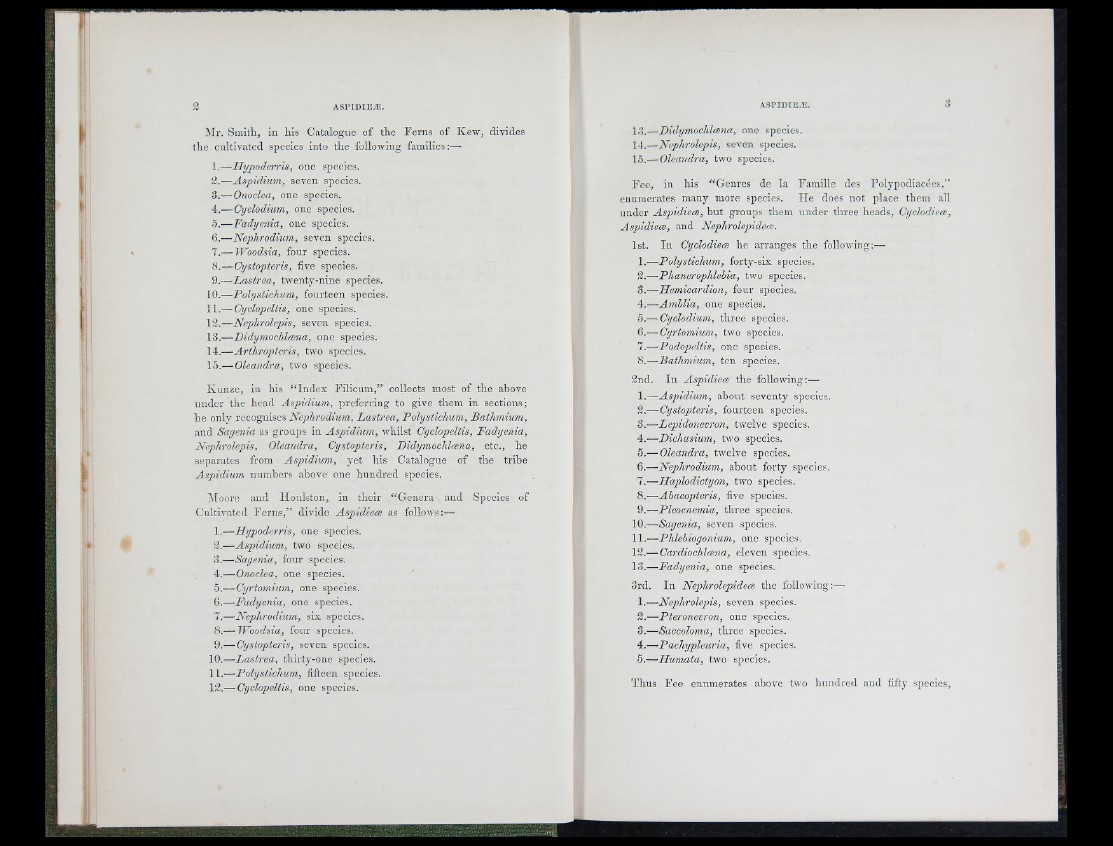
A S P T D lE iE . A S P ID IE C E .
Sir. Smith, in his Catalogue of the Ferns of Kew, divides
the cultivated species into the following families:—
1.—Hypoderris, one species.
a.—Aspidium, seven species.
3.— Onoclea, one species.
4.— Cyalodium, one species.
5.—Fadyenia, one species.
G —Nephrodium,6 ¡s3eCvVCe1n1 soppcecies.
7.— TFoodsia, four species.
8.— Cystopteris, five species.
9.—Lastrea, twenty-nine species.
10.—Pohjsticlium, fourteen species.
Cyclopeltis, one species.
13.—Nephrolepis, seven species.
13.—DidymocMcena, one species.
14.—Artliropteris, two species.
15.—Oleandra, two species.
Ivunze, in his “ Index Filicum,” collects most of the above
under the head Aspidium, preferring to give them in sections;
he only recognises Nephrodium, Lastrea, Polystichum, Bathmium,
and Saycnia as groups in Aspidium, whilst Cyclopeltis, Fadyenia,
Nephrolepis, Oleandra, Cystopteris, Didymochleena, etc., he
separates from Aspidium, yet his Catalogue of the tribe
Aspidium numbers above one hundred species.
Moore and Houlston, in their “ Genera and Species of
Cultivated Ferns,” divide Aspidiece as follows:—
1.—Hypoderris, one species.
3.—Aspidium, two species.
3.—Sagenia, four species.
4.— Onoclea, one species.
5.— Cyrtomiim, one species.
6.—Fadyenia, one species.
7.—Nephrodium, six species.
8.— TFoodsia, four species.
9.— Cystopteris, seven species.
10.—Lastrea, thirty-one species.
11.—Polystichum, fifteen species.
13.— Cyclopeltis, one species.
13.—Didymochleena, one species.
14.—Nephrolejns, seven species.
15.— Oleandra, two species.
Fee, in his “ Genres de la Famille des I’olypodiacées,”
enumerates many more species. l i e does not place them all
under Aspidiece, but groups them under three heads, Cyclodicce,
Aspidiecs, and Nephrolepidece.
1st. In CyclodiecB he arranges the following:—■
1.— Polystichum, forty-six species.
3.—Phanerophlehia, two species.
3.—Hemicardion, four species.
F — Amblia, one species.
5.—■Cyclodium, three species.
6.—Cyrtomium, two species.
7.—Podopeltis, one species.
8.—Bathmium, ten species.
3nd. In Aspidiece the following:—
1.—Aspidiutn, about seventy species.
Cystopteris, fourteen species.
3.—Lepidonevron, twelve species.
4.—Dichasium, two species.
5.— Oleandra, twelve species.
T).— Nephrodium, about forty species.
7.—LLaplodictyon, two species.
8.'—-Ahacopteris, five species.
9.—Pleocnemia, three species.
10.—Sagenia, seven species.
11.—Phlebiogonium, one species.
13..—-Cardiochlcena, eleven species.
13.—Fadyenia, one species.
3rd. Ill Nephrolepidece the following:—
Nephrolepis, seven species.
3.—Pteronevron, one species.
3.—Saccoloma, three species.
^ .— Pachypleuria, five species.
5.—Humata, two species.
Thus Fee enumerates above two hundred and fifty species.